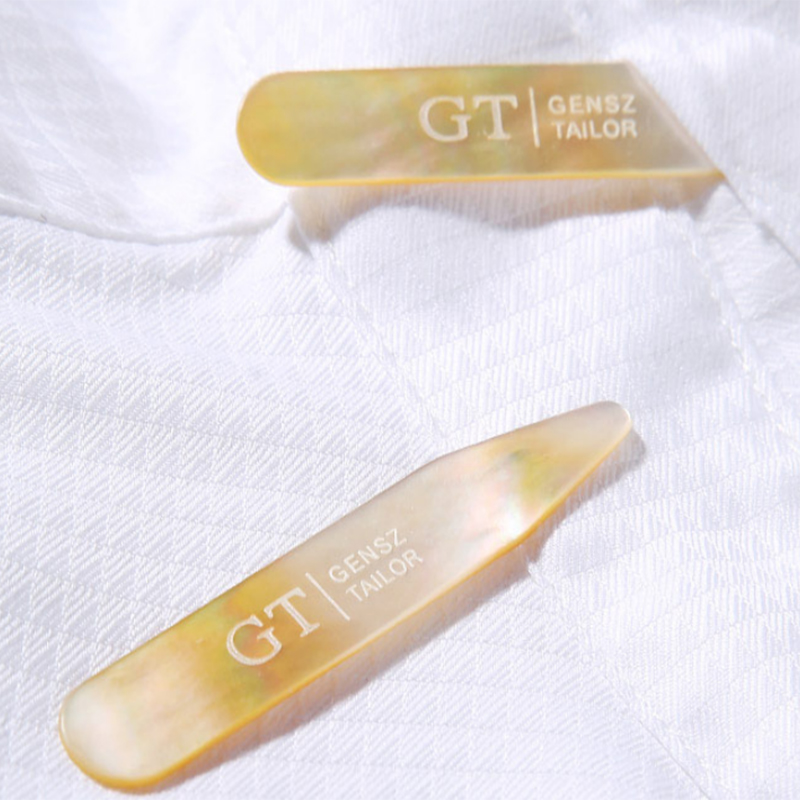What is a shell button?
Tired of plain, synthetic buttons? Elevate your garments with the unique, natural elegance of shell buttons, a touch of luxury often overlooked.
A shell button is a fastener crafted from various types of natural seashells, prized for its iridescence, unique patterns, and eco-friendly appeal in fashion and garment manufacturing.

T-shirt shell buttons
Now that you know the essence of a shell button, you’re likely curious about their composition and history. To truly appreciate these small marvels, let’s explore the materials they’re made from, their historical usage, and why you sometimes see the natural "skin" of the shell.
What are shell buttons made of?
Wondering what gives shell buttons their distinct beauty? The secret lies in diverse natural shells, each offering unique colors and lusters for stylish, sustainable fashion.
Shell buttons are primarily made from various seawater and freshwater pearl oyster shells like White MOP, Black MOP, Yellow MOP, Abalone, and Chinese Freshwater shells, or snail shells like Trocas.

white freshwater shell buttons

whitelip mother of pearl shell buttons

blacklip mother of pearl shell buttons

yellowlip shell buttons
Shell buttons are crafted from a fascinating array of natural materials, lending them unique characteristics and beauty. The most commonly used sources include:
Pearl Oyster Shells:
- White Mother of Pearl (MOP) Shell (Pinctada maxima): Known for its classic creamy white, lustrous surface.
- Black Mother of Pearl (MOP) Shell (Pinctada margaritifera): Offers deep, iridescent greys, blacks, and sometimes hints of green or peacock.
- Yellow Mother of Pearl (MOP) Shell (Pinctada maxima, gold-lipped variety): Provides warm, golden tones.
- Abalone Shell (Haliotis): Famous for its vibrant, swirling patterns of blue, green, purple, and silver.
- Chinese Freshwater Mussel Shells (e.g., Hyriopsis cumingii): A versatile source, often used for various colors and finishes.
Snail Shells:
- Trocas Shell (Trochus niloticus): A popular choice, typically white or cream, often with a subtle pearlescence. It’s durable and takes dyes well.
These natural materials are chosen not only for their beauty but also because they are eco-friendly, fashionable, and recyclable, making them a preferred choice for high-quality garments, from luxury shirts to elegant coat buttons.
When were shell buttons used?
Think shell buttons are a modern trend? Their use in adornment and fastening actually dates back centuries, a testament to their timeless appeal and enduring quality.
Shell buttons have a long history, used for millennia for decoration and fastening, gaining significant popularity in the 19th and early 20th centuries for quality garments.
The use of shells for adornment and practical purposes like fastening garments is far from a new invention. Archaeological evidence suggests shells were used as decorative elements and rudimentary buttons by ancient civilizations thousands of years ago. However, the widespread manufacturing and use of shell buttons as we recognize them today peaked during the 19th and early 20th centuries. The "Pearl Rush" in the Mississippi River Valley, for instance, fueled a massive industry for freshwater mussel shell buttons in the United States.
During the Victorian era and into the Art Deco period, mother-of-pearl buttons were a hallmark of quality clothing, gracing everything from fine silk blouses and men’s shirts to undergarments and children’s wear. Their natural luster and durability made them a preferred choice before the advent of plastics. Even today, they signify a touch of classic elegance and attention to detail in garment construction.
Why do some buttons have the shell skin?
Noticed the natural outer layer on some shell buttons? This isn’t a flaw, but often a deliberate choice balancing cost, aesthetics, and material properties.
Some shell buttons retain part of the shell’s outer "skin," typically on the reverse, as a cost-effective measure, especially since shells are naturally thin and achieving perfectly flat, skinless sides increases expense.

thin shell buttons with shell skin
The presence of the shell’s natural outer "skin" on some buttons, usually on the back, is primarily driven by cost considerations and material characteristics. Here’s a breakdown:
Cost Implications:
Shell materials, while beautiful, are natural products. Compared to synthetic resin buttons, genuine shell buttons are inherently more expensive due to the sourcing and processing of the raw material. Shells are also naturally relatively thin.
Material Thickness and Processing:
- Perfectly Flat & Skinless: To produce a button that is perfectly flat on both sides and completely free of any outer skin, more of the raw shell material might need to be ground away, or very specific, thicker parts of the shell must be used. This increases labor, processing time, and material waste, leading to a higher-priced button.
- Retaining Some Skin: For clients who desire the beauty of genuine shell but are working within a tighter budget, or for applications where the back of the button isn’t prominently visible, manufacturers may opt to leave a thin layer of the natural shell "skin" on the reverse. This allows for the use of slightly thinner shell sections or less intensive grinding, making the button more affordable while still offering the desirable qualities of the shell material on the front.
This approach helps cater to a broader market, offering genuine shell button options at different price points without compromising the visible aesthetic of the button’s face.
Conclusion
Shell buttons offer natural elegance, with diverse material origins and a rich history. Understanding variations like retained skin helps appreciate their value and manufacturing practicality.






